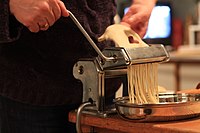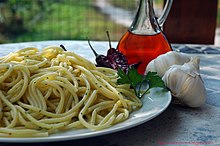Spaghetti
The spaghetti (from Italian, spaghetti [spaˈɡetti] ; singular, spaghetto) is a type of Italian pasta made with durum flour and water. It has the shape of a thin long rope, circular section and an approximate size between 25 and 30 centimeters. It is one of the most representative ingredients of Italian gastronomy, whose popularity transcends other countries.
History
The first reference to dry pasta and the pasta industry in Italy is a description of the Kingdom of Sicily under Roger II in the 12th century. In the geographical work Kitab Ruyar ("Roger's Book"), the cartographer Al-Idrisi describes that in Trabia, 29 kilometers from Palermo, there are mills where spun and manually molded pasta is made, which he calls itriyya (in Arabic, pasta cut into thin strips), and derived in turn from the lagănum of Roman times, which was exported to other Mediterranean markets.
The word spaghetti was used for the first time in the poem «Li maccheroni di Napoli» (Antonio Viviani, 1824), and is a diminutive of the term spago, which in Italian means "string". Since then the word spaghetti has replaced other older Italian terms such as maccheroni (or maccaroni) and vermicelli (literally “ little worms”, in Italian), previously used to refer to spaghetti.
In terms of consumption, spaghetti was initially served only with olive oil and minced garlic (aglio e olio), or with cheese and pepper (cacio e pepe ). It is from the 18th century when the consumption of pasta with tomato sauce was consolidated, documented in the recipe book Cucina teorico pratica by Ippolito Cavalcanti (1837) in two recipes: «I vermicelli con lo pommodoro” (vermicelli with tomato) and “Ragù napoletano”.
Preparation
Fresh pasta is made with durum flour and water as basic ingredients for the dough. In an artisan way, the dough is stretched with a rolling pin to the desired thickness and then cut with a knife into thin ropes, the size of which ranges from 25 to 50 centimeters. There are also machines to make pasta that simplify the process and allow a more uniform cut. Once the spaghetti has been obtained, it must be hung to dry before being cooked. However, the spaghetti that is most consumed is the industrial one, manufactured by extrusion.
To cook spaghetti, whether fresh or industrial, you need to boil the pasta in a pot with salted water until it softens. The most common consistency in Italy is al dente, that is, it offers some resistance when bitten. Under no circumstances should oil be added to the water used to cook the pasta, as this is a common mistake in many countries.
Once cooking has finished, the spaghetti is removed with a strainer (in Italian, scolapasta) or with tongs to remove excess water. If you want to add tomato sauce or any other variety, it is recommended that the spaghetti finish in the pan and sauté for a couple of minutes to bind the flavors. When serving, it is common to add a little grated cheese (Parmesan) on top, Pecorino Romano or Grana Padano).
There are different varieties of spaghetti depending on the diameter. From smallest to largest are the spaghettini (n. 3), the spaghetti (n. 5) and the spaghettoni (n. 8).
Plates of spaghetti
This section includes only some of the best-known variants when it comes to preparing spaghetti:
- Spaghetti alle vongole: spaghetti with garlic and olive oil, white wine and clams. It is a representative dish of the Neapolitan cuisine.
- Spaghetti alla puttanesca: spaghetti sausages with olive oil, garlic, tomato, screen, capers, black olives and anchovies. The recipe originates in southern Italy and its literal translation is "spagueti in the style of prostitutes"
- Spaghetti with meatballs: a dish of the Italian-American gastronomy in which spaghetti jump with meat meat meat meat meat meat in tomato sauce.
- Carbonara: original Latius dish whose original recipe includes egg yolk, Roman pecorino cheese, guanciale and black pepper.
- Cacio and pepe: salted spaghetti with black pepper, pecorino cheese and pasta cooking water. It's traditional from Rome.
Contenido relacionado
Tartar
Gastronomy of Chile
Menkiri bōchō



